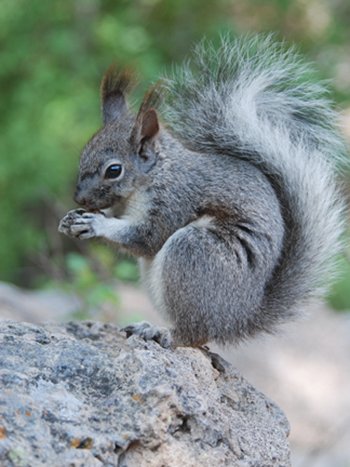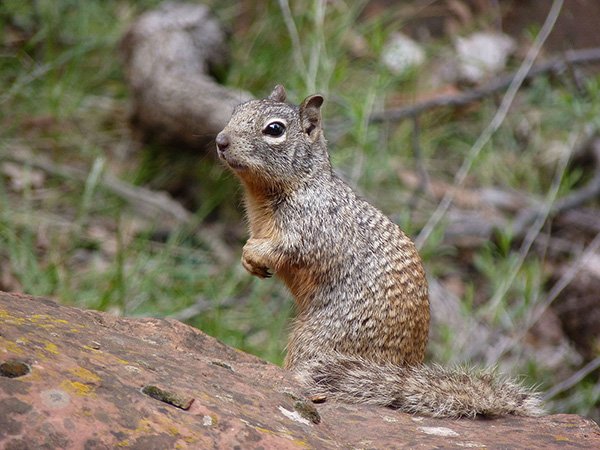The Not-So-Nutty Habits of Squirrels
The squirrel family (Sciuridae) is quite large, including species such as chipmunks, flying squirrels, woodchucks, and prairie dogs. There are red, gray, white, and black squirrels. There are tiny squirrels (like the tiny two-inch pygmy squirrel in Africa) and large squirrels (like the nearly 20-pound gray marmot1 in Kazakhstan). In fact, squirrels live on almost every continent in the world. It’s hard to go anywhere without running into a squirrel. Throughout my life, I’ve encountered quite a few up close.
When I was a little girl, my dad rescued a flying squirrel and let me help nurse it back to health. In a fallen tree, my brother once found three squirrel kits (baby squirrels), which we took to a rescue sanctuary. And not long ago my dad found a baby squirrel, named him Earl, and raised him in his shirt pocket for weeks. One day, Earl leaped to the nearest branch and launched into the great beyond.
However, far from appreciating them, most people consider these rascally rodents to be pests. They dash haphazardly in front of cars,2 they chew on wires and insulation, and they loot bird feeders. But a closer look past their annoying habits reveals a creature designed by the Creator with some not-so-nutty—actually brilliant—behaviors.

Image via Wikimedia Commons (public domain)
Abert’s Squirrel
Resourceful Rodents
Though squirrels can’t seem to make up their mind which side of the road they want to be on, God equipped squirrels with prudent forethought and clever resourcefulness.
Making Themselves at Home
Squirrels generally build their nests by chewing holes in trees (or sometimes your attic). But in case of emergencies, squirrels keep extra nests nearby. If threatened by a predator or other dangers in the environment, they pack up the kits and move to a second or third home.
The holes they chew in trees make nice homes for animals that move in after them.
Dinner and a Show
You’ve probably seen a squirrel finding creative ways to help itself to the birdseed buffet you meant for your feathered friends. With headstands, jumps, and trapeze feats, it’s like a circus in your backyard.
However, whether they have access to your feeder or not, squirrels will find something to eat. When seeds or nuts are scarce, they munch on insects, fruits, vegetables, and even scraps of food such as cheese. Squirrels have even been seen making mushroom jerky by laying strips of mushroom to dry on branches.3
In areas with sugar maple trees, squirrels nibble through the bark, allowing the sap to drip out and dry. The squirrels return later to lick the sugar residue off the bark, enjoying a quick energy boost.4
Stealth Stashers
Squirrels work hard to gather enough nuts to last the winter (3,000–10,000 by some estimates5). So to keep other animals from stealing their stash, squirrels will sometimes pretend to bury nuts and seeds in case they are being watched. They will also bury nuts several times, to throw off potential thieves. The next time you spot a squirrel in your yard or at the park, see if you can catch it in a deceitful dig. This ability to purposefully deceive other animals is a trait of highly intelligent creatures such as primates.6

Image via Wikimedia Commons (public domain)
Rock Squirrel in Zion National Park
Chunking Champions
When I carry in my groceries from the store, I sort them by category so that I can easily remember where they go: vegetables in the fridge drawer, fruit on the counter, canned goods in the pantry, and ice cream in the freezer. Squirrels often do the same thing with their food by burying the same type of nuts or seeds in the same spots. This strategy, called chunking, helps them remember where they’ve hidden their food.
Absentminded Arborists?
Squirrels often forget where they bury their seeds and nuts. In fact one study found that squirrels leave behind up to 74% of the acorns they bury. Though we might initially think they are absentminded or wasteful, squirrels accidentally plant many trees this way. Acorns sprout best when out from under the shade of a tree. Squirrels know that there is a better chance of another animal finding their acorns when they stash them right under a tree, so they are more prone to bury acorns in more open areas. What better way for an acorn to travel to a sunny spot than by squirrel?
Conclusion
Squirrels aren’t quite as “nutty” as you might have thought. In fact, when you look closely, you’ll see that God gave this species fascinating survival instincts and behaviors. Maybe today you can leave out a few nuts or seeds (walnuts, hickory nuts, and hazelnuts are their favorites), and remember to give thanks to the Creator who allows us to live among these bright-eyed, bushy-tailed critters.
Footnotes
- Just outside Austin, Texas, you can see a 14-foot statue of a squirrel named Ms. Pearl, probably having something to do with the pecan candy and gift shop nearby.
- Ever wonder why squirrels show erratic behavior when crossing the road? It’s part of their God-given survival instinct. Running in a zigzag pattern helps them evade predators like hawks. But of course it doesn’t work so well to protect them from the four wheels of your vehicle.
- Jenny Lee, “Squirrels Eat Mushrooms?,” Chattermarks, October 8, 2008, http://chattermarks.ncascades.org/naturalist-notes/squirrels-eat-mushrooms/.
- John Roach, “No Nuts, No Problem: Squirrels Harvest Maple Syrup,” National Geographic News, February 18, 2005, https://news.nationalgeographic.com/news/2005/02/0218_050218_squirrels.html.
- Kendra Pierre-Louis, “Squirrels Are So Organized It’s Nuts,” Popular Science, September 14, 2017, https://www.popsci.com/squirrels-organized.
- University of Richmond, “Researchers Tackle the Nutty Truth on Acorns and Squirrels,” November 26, 1998, https://www.sciencedaily.com/releases/1998/11/981126102802.htm.
- © 2024 Answers in Genesis
- Privacy Policy
- Contact
- About
